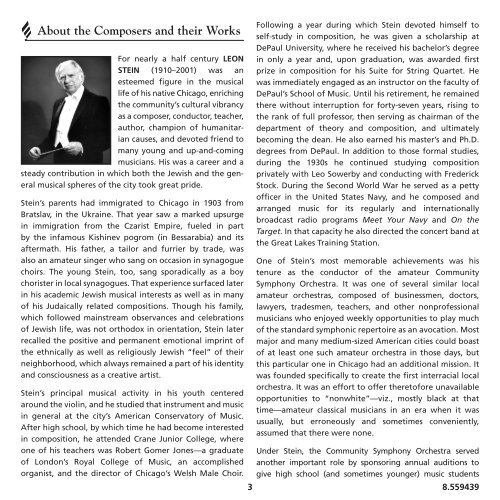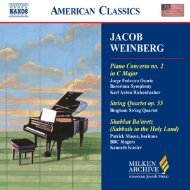Download Liner Notes PDF - Milken Archive of Jewish Music
Download Liner Notes PDF - Milken Archive of Jewish Music
Download Liner Notes PDF - Milken Archive of Jewish Music
You also want an ePaper? Increase the reach of your titles
YUMPU automatically turns print PDFs into web optimized ePapers that Google loves.
About the Composers and their WorksFor nearly a half century LEONSTEIN (1910–2001) was anesteemed figure in the musicallife <strong>of</strong> his native Chicago, enrichingthe community’s cultural vibrancyas a composer, conductor, teacher,author, champion <strong>of</strong> humanitariancauses, and devoted friend tomany young and up-and-comingmusicians. His was a career and asteady contribution in which both the <strong>Jewish</strong> and the generalmusical spheres <strong>of</strong> the city took great pride.Stein’s parents had immigrated to Chicago in 1903 fromBratslav, in the Ukraine. That year saw a marked upsurgein immigration from the Czarist Empire, fueled in partby the infamous Kishinev pogrom (in Bessarabia) and itsaftermath. His father, a tailor and furrier by trade, wasalso an amateur singer who sang on occasion in synagoguechoirs. The young Stein, too, sang sporadically as a boychorister in local synagogues. That experience surfaced laterin his academic <strong>Jewish</strong> musical interests as well as in many<strong>of</strong> his Judaically related compositions. Though his family,which followed mainstream observances and celebrations<strong>of</strong> <strong>Jewish</strong> life, was not orthodox in orientation, Stein laterrecalled the positive and permanent emotional imprint <strong>of</strong>the ethnically as well as religiously <strong>Jewish</strong> “feel” <strong>of</strong> theirneighborhood, which always remained a part <strong>of</strong> his identityand consciousness as a creative artist.Stein’s principal musical activity in his youth centeredaround the violin, and he studied that instrument and musicin general at the city’s American Conservatory <strong>of</strong> <strong>Music</strong>.After high school, by which time he had become interestedin composition, he attended Crane Junior College, whereone <strong>of</strong> his teachers was Robert Gomer Jones—a graduate<strong>of</strong> London’s Royal College <strong>of</strong> <strong>Music</strong>, an accomplishedorganist, and the director <strong>of</strong> Chicago’s Welsh Male Choir.Following a year during which Stein devoted himself toself-study in composition, he was given a scholarship atDePaul University, where he received his bachelor’s degreein only a year and, upon graduation, was awarded firstprize in composition for his Suite for String Quartet. Hewas immediately engaged as an instructor on the faculty <strong>of</strong>DePaul’s School <strong>of</strong> <strong>Music</strong>. Until his retirement, he remainedthere without interruption for forty-seven years, rising tothe rank <strong>of</strong> full pr<strong>of</strong>essor, then serving as chairman <strong>of</strong> thedepartment <strong>of</strong> theory and composition, and ultimatelybecoming the dean. He also earned his master’s and Ph.D.degrees from DePaul. In addition to those formal studies,during the 1930s he continued studying compositionprivately with Leo Sowerby and conducting with FrederickStock. During the Second World War he served as a petty<strong>of</strong>ficer in the United States Navy, and he composed andarranged music for its regularly and internationallybroadcast radio programs Meet Your Navy and On theTarget. In that capacity he also directed the concert band atthe Great Lakes Training Station.One <strong>of</strong> Stein’s most memorable achievements was histenure as the conductor <strong>of</strong> the amateur CommunitySymphony Orchestra. It was one <strong>of</strong> several similar localamateur orchestras, composed <strong>of</strong> businessmen, doctors,lawyers, tradesmen, teachers, and other nonpr<strong>of</strong>essionalmusicians who enjoyed weekly opportunities to play much<strong>of</strong> the standard symphonic repertoire as an avocation. Mostmajor and many medium-sized American cities could boast<strong>of</strong> at least one such amateur orchestra in those days, butthis particular one in Chicago had an additional mission. Itwas founded specifically to create the first interracial localorchestra. It was an effort to <strong>of</strong>fer theret<strong>of</strong>ore unavailableopportunities to “nonwhite”—viz., mostly black at thattime—amateur classical musicians in an era when it wasusually, but erroneously and sometimes conveniently,assumed that there were none.Under Stein, the Community Symphony Orchestra servedanother important role by sponsoring annual auditions togive high school (and sometimes younger) music students 8.559439
















